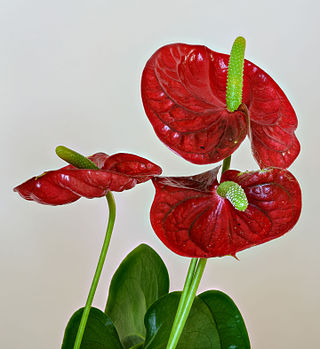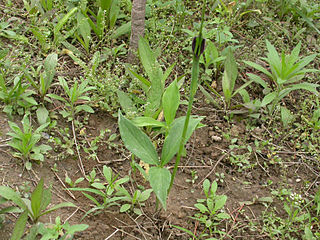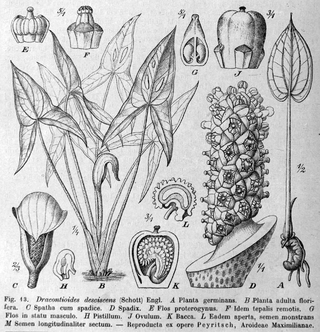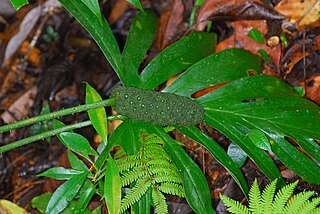
The Alismatales (alismatids) are an order of flowering plants including about 4,500 species. Plants assigned to this order are mostly tropical or aquatic. Some grow in fresh water, some in marine habitats. Perhaps the most important food crop in the order is the corm of the taro plant, Colocasia esculenta.
The Cronquist system is a taxonomic classification system of flowering plants. It was developed by Arthur Cronquist in a series of monographs and texts, including The Evolution and Classification of Flowering Plants and An Integrated System of Classification of Flowering Plants (1981).

Acorus is a genus of monocot flowering plants. This genus was once placed within the family Araceae (aroids), but more recent classifications place it in its own family Acoraceae and order Acorales, of which it is the sole genus of the oldest surviving line of monocots. Some older studies indicated that it was placed in a lineage, that also includes aroids (Araceae), Tofieldiaceae, and several families of aquatic monocots. However, modern phylogenetic studies demonstrate that Acorus is sister to all other monocots. Common names include calamus and sweet flag.

Acorus calamus is a species of flowering plant with psychoactive chemicals. It is a tall wetland monocot of the family Acoraceae, in the genus Acorus. Although used in traditional medicine over centuries to treat digestive disorders and pain, there is no clinical evidence for its safety or efficacy – and ingested calamus may be toxic – leading to its commercial ban in the United States.

Anthurium is a genus of about 1,000 species of flowering plants, the largest genus of the arum family, Araceae. General common names include anthurium, tailflower, flamingo flower, and laceleaf.
The Kubitzki system is a system of plant taxonomy devised by Klaus Kubitzki, and is the product of an ongoing survey of vascular plants, entitled The Families and Genera of Vascular Plants, and extending to 15 volumes in 2018. The survey, in the form of an encyclopedia, is important as a comprehensive, multivolume treatment of the vascular plants, with keys to and descriptions of all families and genera, mostly by specialists in those groups. The Kubitzki system served as the basis for classification in Mabberley's Plant-Book, a dictionary of the vascular plants. Mabberley states, in his Introduction on page xi of the 2008 edition, that the Kubitzki system "has remained the standard to which other literature is compared".
Arecidae is a botanical name at the rank of subclass. Circumscription of the subclass will vary with the taxonomic system being used ; the only requirement being that it includes the family Arecaceae.

Pinellia is a genus of plants in the family Araceae native to East Asia. Its species are commonly called green dragons due to the color and shape of the inflorescence, which possesses a green, hooded spathe from which protrudes a long, tongue-like extension of the spadix. The leaves vary greatly in shape among different species, from simple and cordate to compound with three to many leaflets. Pinellia reproduces rapidly from seed and many species also produce bulbils on the leaves. Both characteristics have allowed some species to become weedy in temperate areas outside their native range, notably Pinellia ternata in eastern North America.

Callopsis is a monotypic genus from the plant family Araceae and has only one species, Callopsis volkensii. This plant forms a creeping rhizome and has cordate-ovate leaves that are medium green and glabrous. The inflorescence is typical of the family Araceae, with a white spathe and yellow spadix. The spadix is shorter than the spathe and its male and female flowers are separated shortly.
Alloschemone is a genus of evergreen root climbing plants in the family Araceae that is native to the Amazon region of Bolivia and Brazil. There are only two species in the genus and both are extremely rare. These two species are Alloschemone occidentalis and Alloschemone inopinata. At one point in history, the genus Alloschemone was dissolved and added to Scindapsus, but it has since been reinstated after further observations of the plants.
Anaphyllopsis is a genus of flowering plants in the family Araceae, native to northern South America.

Cyrtosperma is a genus of flowering plants in the family Araceae. The genus went through considerable taxonomic changes in the 1980s, and as a result is now considered to be native only to Southeast Asia and some Pacific islands. Previously, the genus was believed to be widespread from Asia to Africa and South America, but the African and South American species were subsequently moved into separate genera. Cyrtosperma is now known to be most prominent in New Guinea. The genus Cyrtosperma is unique in this regards because it is the only known big genus in Araceae that is known to be found east of Wallace's line.

Dracontioides is a genus of flowering plants in the family Araceae. It was long thought to contain only a single species until a second species was described in 2005. Both are endemic to Brazil.

Lasia is a genus of flowering plants in the family Araceae, native to Asia and New Guinea. The genus contains only two known species, Lasia spinosa and Lasia concinna. Lasia was believed to be a monotypic genus until 1997 when a wild population of Lasia concinna was discovered in a farmer's paddy field in West Kalimantan, Indonesia. The farmer had been growing them for their edible young leaves. This species of Lasia had been known of previously only from a single specimen at the Bogor Botanic Gardens, formally described in 1920. Prior to 1997, the specimen was believed to have been a hybrid between Lasia spinosa and Cyrtosperma merkusii. The subsequent discovery by Hambali and Sizemore led to the realization that it was in fact a distinct species.
Mangonia is a genus of flowering plants in the family Araceae. The genus contains only two known species native to southern Brazil and Uruguay.
- Mangonia tweedieanaSchott. - Rio Grande do Sul, Uruguay
- Mangonia uruguaya(Hicken) Bogner - Cerro Largo in Uruguay
Phymatarum is a genus of flowering plants in the family Araceae. It contains only one known species, Phymatarum borneense, native to Brunei and Sarawak on the Island of Borneo.
Filarum is a monotypic genus of flowering plants in the family Araceae. The single species making up the genus is Filarum manserichense. It is found growing in the amazonian region of northeastern Peru. Govaerts, R. & Frodin, D.G. (2002). World Checklist and Bibliography of Araceae : 1–560. The Board of Trustees of the Royal Botanic Gardens, Kew. The fertile male flowers of Filarum are unique in that they have hairlike attachment to them.

Pseudohydrosme is a genus of flowering plants in the family Araceae. It contains only three species, Pseudohydrosme buettneri, Pseudohydrosme gabunensis, and more recently Pseudohydrosme ebo, two being endemic to tropical rain forests in Gabon, and the other being native to the Ebo Forest of Cameroon. The genus is believed to be closely related to Anchomanes and is likely to be sunk into Anchomanes due to molecular evidence.
Spathantheum is a genus of flowering plants in the family Araceae. The genus contains two species, Spathantheum fallax and Spathantheum orbignyanum. Spathantheum is believed to be closely related to Spathicarpa. The genus is endemic to the Andes of Peru, Bolivia, and northern Argentina and is found growing in grasslands in rocky soil.
- Spathantheum fallax Hett., Ibisch & E.G.Gonç. - Bolivia
- Spathantheum orbignyanumSchott - Peru, northwestern Argentina, Bolivia

Theriophonum is a genus of flowering plants in the family Araceae. It is found only in India and Sri Lanka. The genus is closely related to Typhonium. The only apparent difference between the two is in how many ovules each have and the overall size of the plants. Typhoniums are bigger than Theriophonum.
- Theriophonum dalzelliiSchott - western India
- Theriophonum danieliiRajakumar, Selvak., S.Murug. & Chellap - southern India
- Theriophonum fischeriSivad. - Kerala, Tamil Nadu
- Theriophonum infaustumN.E.Br. - Kerala
- Theriophonum manickamiiMurugan & K.Natarajan - Tamil Nadu
- Theriophonum minutum(Willd.) Baill. - central and southern India, Sri Lanka. Also known as Theriophonum crenatum
- Theriophonum sivaganganum(Ramam. & Sebastine) Bogner - Tamil Nadu











